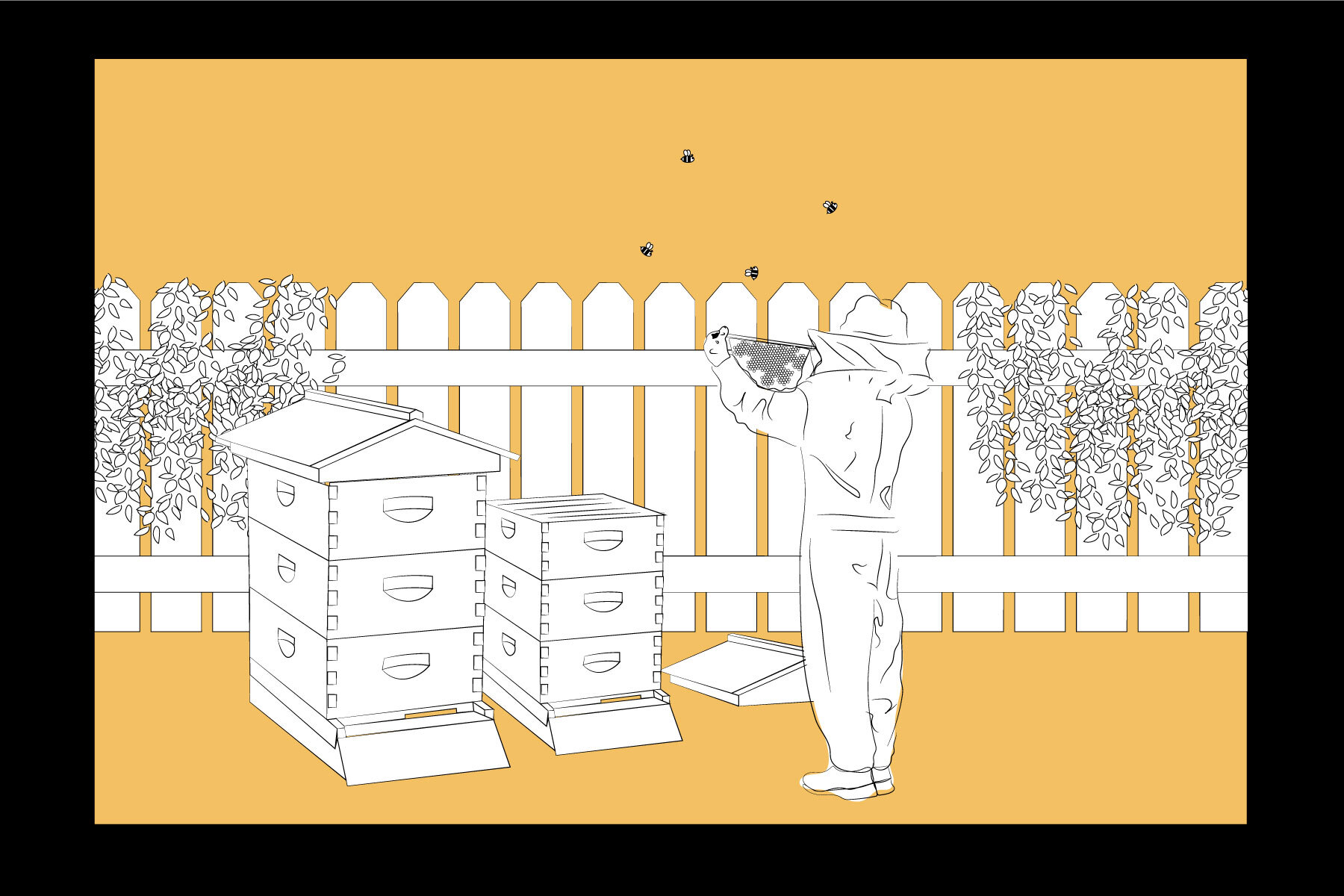Bees: Everyone loves them, everyone needs them, but not everyone is comfortable around them — nor should they be. It is an interesting paradox that one of the most valuable pollinators and profitable animals in the world are also flying hypodermic needles. Perhaps the greater paradox then, is that bees are one of the few domesticated livestock that almost anyone can take care of.
Bees have been kept in urban and suburban settings for centuries, with the ancient Egyptians among the first to crack the code in domesticating the hard-working insects in 2422 B.C. Unlike the dangerous and seasonal honey-hunting method used by other civilizations, the Egyptians found that by capturing young colonies and housing them in their gardens, they could get a near unlimited supply of honey and wax.
This method also yielded another bonus — as the bees became more acclimated to human activity, and their keepers bred the docile queens, the bees would become domesticated like cows and sheep. Eventually, these ancient beekeepers were not only sought after for their honey and wax, but also for their specially bred colonies that could be sold to wealthy clients and farmers.
The specialized skills these beekeepers possessed alongside their sought-after products conferred a special set of privileges and respect to beekeepers; families of beekeepers in the Roman and medieval world could become quite wealthy. Beekeepers would often live and work in or just outside of the cities — depending on who their clientele was.
As cities grew denser, the 19th century saw a drastic decrease in urban beekeeping. Beekeeping moved away from small local operations to the larger agricultural ventures that are more familiar to modern times.
Many cities in North America made the practice illegal, though that rarely stopped enterprising enthusiasts such as the A.I Root Company, which began supplying Manhattan residents with beekeeping supplies in 1905, and it even operated 28 apiaries on the roof of a building on Vesey Street.
Opinions on urban beekeeping have largely reversed in recent decades, and most cities in North America and the world now engage in programs to increase beekeeping within the city limits, like the Michigan Urban Farming Initiative.
Beekeeping Benefits
Because of beekeeping’s relatively inexpensive initial investment of around $300 to get started on working a hive (cheaper than buying a new PS4), the wealth of information available to newbies and the potential for a monetary return greater than the initial investment, it has become one of the fastest growing hobbies in the U.S.
What is most attractive to keepers, old and new alike, is the ease of working with the bees. Unlike other types of livestock, bees are highly self-sufficient, and when placed in a good spot, a hive will take care of itself. A beekeeper only needs to check on their hive about once or twice a week; one of the more difficult aspects of beekeeping is making sure your hive does not grow too quickly.
This is because bees’ self-sufficiency also makes them independent from the keeper in a way that other domesticated animals are not. Should a hive start to become stressed due to overcrowding, they will swarm, a reproductive phenomenon where a large portion of a colony’s bees will gather around a young queen and leave the hive in order to look for a new home.
Contrary to popular belief, this swarming behavior is not aggressive, and it’s during this time that bees are at their most docile. Although a sudden swarm of bees appearing on one’s property can be scary, it’s advisable to call a local beekeeping company or club, as they are more than willing to peacefully collect the feral hives and may even compensate you.
For backyard beekeepers, swarms might be an annoyance, but they are also easily prevented by ensuring that the brood nest is open. This allows new queens and their young to leave periodically, without causing a massive split.
The Risks
This is not to say that beekeeping is without its dangers. Most honeybees are of the Apis cerana species and have been made docile through centuries of breeding. Good keepers will almost never get stung or agitate their hives to the point where stinging becomes a possibility.
However, not all honeybees in the U.S. are as tranquil, and western states in particular have more aggressive bee populations due to widespread interbreeding with Africanized bees.
Africanized bees are a combination of various European honeybees and the South African Lowland Bee. These hybrids are prized for their hardy constitutions, increased productivity and near-immunity to colony collapse disorder, but they are also far more aggressive and should only be kept outside of urban areas. It is for this reason that urban beekeepers and hobbyists living in the western United States should take extra care in vetting where their bees come from.
Aside from potential threats to beekeepers, there are also a variety of threats that the bees themselves face in urban or suburban areas.
Though urban bees are much healthier on average than their rural counterparts, owing in part to fewer predators and pesticide exposure, they are still vulnerable to invasive species like red fire ants, hive beetles and the dreaded Varroa mite — one of the main causes of colony collapse disorder.
Savvy keepers can easily mitigate these threats by building their hive boxes in safe locations and using naturally occurring pesticides that target parasites without poisoning their bees.
For most urban beekeepers, these risks are part of the fun. Although a single large hive in an urban setting can net its owner an average of $556.22 per year, beekeeping is not a monetary venture for most in the community, but a hobby.
Like gardening or keeping chickens, there is a deep sense of satisfaction that comes with cultivating and caring for life. Beekeeping confers a certain sense of responsibility, as the health of the local ecology of neighborhoods and cities is often directly correlated with the health of its pollinators.
There is an undeniable sense of altruism one feels when regularly interacting with stinging, crawling, buzzing creatures for the betterment of humankind and their environment — but the money isn’t too bad either.
















